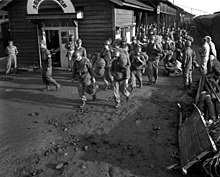Chaplain–Medic massacre
The Chaplain–Medic massacre took place in the Korean War on July 16, 1950, on a mountain above the village of Tuman (current Duman-ri, Geumnam-myeon, Sejong City).The same month, the KPA commanders, concerned about the way their soldiers were treating prisoners of war, laid out stricter guidelines for handling enemy captives.[8] These American soldiers, most of whom had experienced only occupation duty in Japan and no actual combat, were unprepared compared to the more disciplined North Korean units.[12] The Geum River wrapped north and west around the city, providing a defensive line 10–15 miles (16–24 km) from the outskirts of Daejon, which is protected on the south by the Sobaek Mountains.[19] KPA troops promptly set up a roadblock directly behind the 19th Infantry's line in its main route of supply along the road near the village of Tuman, just south of Yusong on Taejon's western outskirts.Captain (Chaplain) Felhoelter distinguished himself by extraordinary heroism in action against enemy aggressor forces on the Kum River, north of Taejon, Korea, on 16 July 1950.—Citation[31] The regimental medical officer, Captain Linton J. Buttrey, and Chaplain Herman G. Felhoelter[32] remained behind with the wounded, intending to move them when another group of troops came through who could carry them.After the Chaplain–Medic, Hill 303 and Bloody Gulch massacres, US commanders established a commission on July 27 to investigate allegations of war crimes and collect evidence.[44] Buttrey, the lone survivor of the executions, was called to testify before the committee, and the US government concluded that the KPA violated the terms of the Geneva Convention, and condemned its actions.[46] Subsequent research has found the KPA command did not directly order its troops to mistreat prisoners[47] or unarmed wounded during the early phase of the war.[42] The Chaplain–Medic massacre and similar atrocities are believed to have been conducted by "uncontrolled small units, by vindictive individuals, or because of unfavorable and increasingly desperate situations confronting the captors".[48] T. R. Fehrenbach, a military historian, wrote in his analysis of the event that KPA troops committing these acts were probably accustomed to torture and execution of prisoners due to decades of rule by oppressive armies of the Empire of Japan up through World War II.The document was signed by Kim Chaek, Commander-in-Chief,[47] and Choi Yong-kun, commander of the KPA Advanced General Headquarters, and stated that killing prisoners of war was "strictly prohibited".The higher-profile Hill 303 massacre the next month prompted KPA division commanders to issue sterner orders on the treatment of prisoners of war.



Geumnam-myeon, Sejong CityCoordinatesU.S. Armyprisoners of warRoman CatholicchaplainKorean People's ArmyKorean WarPokpungChuncheonGorangpoKaesong–MunsanOngjinUijeongbu1st SeoulSuwon AirfieldAir CampaignAndongChumonchin ChanPyongtaekChonanChochiwonTaejonSangjuYongdongHwangganHadongPusan PerimeterP'ohang-dong1st Naktong BulgeBowling AlleyBattle MountainKyongjuNam RiverKa-sanTabu-dongYongsan2nd Naktong BulgeInchonPusan Perimeter offensive2nd SeoulUN September 1950 counteroffensiveHill 282UN offensive into North KoreaSariwonPyongyangYongyuChongjuSunchon tunnelOnjongPakchonSecond Phase OffensiveCh'ongch'on RiverChosin ReservoirTask Force FaithUN retreat from North KoreaHungnam evacuation3rd Seoul1st and 2nd WonjuPohangHappy ValleyThunderboltTwin TunnelsRoundupHoengsongChipyong-ni3rd WonjuChuam-niWonsanKiller4th Seoul (Operation Ripper)Maehwa-sanCourageousTomahawkRuggedDauntlessSpring offensiveImjin RiverYultongHwacheonKapyongSoyang RiverUN May–June 1951 counteroffensiveBloody RidgeMindenPunchbowlHeartbreak RidgeCommando1st Maryang-sanHaktang-niPolecharge2nd Maryang-sanRat KillerHill EerieOld BaldyBunker HillOutpost KellyWhite Horse HillArrowhead HillTriangle HillJackson Heights1st Hook2nd HookChatkolOutpost VegasPork Chop HillHill 187Little SwitchNevada Complex3rd HookOutpost HarryKumsongBerlin Outposts and Boulder CitySamichon RiverKorean Armistice AgreementBig SwitchPanmunjom DeclarationMiG AlleySunchonStrangleSui-ho DamBombing of North Korea 1950–1953Battle of Korea StraitBattle of Chumonchin ChanBattle of HaejuBattle of Inchon